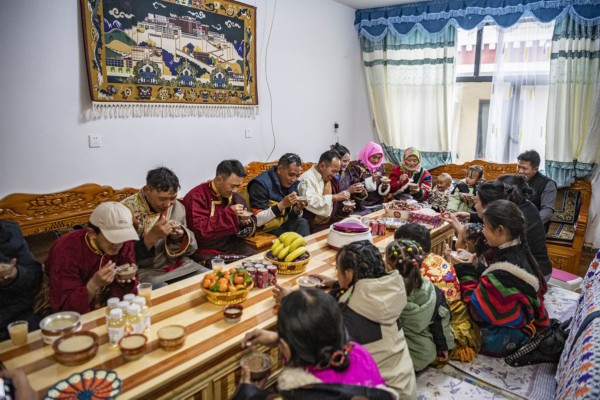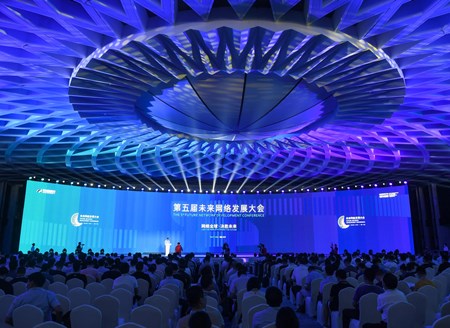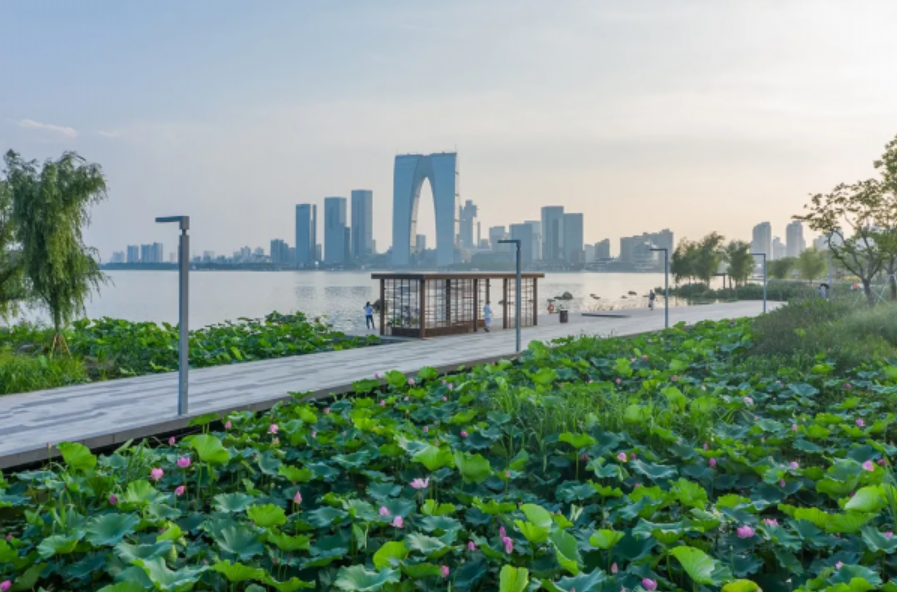* The 2023 Tibetan New Year falls on Feb. 21, almost a month after the Spring Festival. The celebration usually starts on the first day of the first month of the Tibetan calendar and ends after 15 days.
* Just like the Spring Festival, the Tibetan New Year marks the perfect opportunity for Tibetans to reunite with their relatives and friends.
* Business has been exceptionally good this year, said Tsering Nima, a merchant of Barkhor Mall. With the optimized COVID response, shops and stalls have gradually regained popularity.
LHASA, Feb. 21 (Xinhua) -- On Tuesday, the first day of the Year of the Water Rabbit under the Tibetan calendar, people across Lhasa, the capital of southwest China's Tibet Autonomous Region, greeted each other with the phrase "Losar Tashi Delek" (Happy Tibetan New Year).

A girl presents the chema box, a two-tier rectangular wooden box containing roasted barley and fried wheat grain, to celebrate the Tibetan New Year in Lhasa, southwest China's Tibet Autonomous Region, Feb. 21, 2023. (Xinhua/Jigme Dorje)
Starting Monday evening, throughout the whole night, fireworks and sparklers popped, glittered, and lit up the sky over Lhasa.
Across Barkhor Street in downtown Lhasa, decorations such as red Tibetan New Year couplets, exquisite chema boxes (a two-tier rectangular wooden box containing roasted barley and fried wheat grain), auspicious sheep heads, colorful dyed flowers accompanied the hustle and bustle of large shopping crowds.
"Business has been exceptionally good this year," said Tsering Nima, a merchant of Barkhor Mall. With the optimized COVID response, shops and stalls have gradually regained popularity.
The Spring Festival boom has just ended, and now the fervor of the Tibetan New Year has risen again, Tsering Nima said.
On Feb. 18, Tashi Phuntsog woke up early and drove from his Singpori community to Lhasa for some festive shopping.
"In addition to the essentials for the new year, including Kasai (a traditional Tibetan fried pastry made of flour and butter) and a chema box, I also bought new clothes for my family. We will celebrate the new year in our new home in Singpori," he said.
Back when they used to live in Tsonyi, China's highest county, they had to go to the nearby counties of Nyima and Bangoin, which are still hundreds of kilometers away, to shop for the new year.
"After the relocation, there are more choices for us and it is more convenient," said Tashi Phuntsog, who spent altogether 4,100 yuan (about 598 U.S. dollars) for the goods.

Tashi Phuntsog does festive shopping at Barkhor Mall in Lhasa, southwest China's Tibet Autonomous Region, Feb. 18, 2023. (Xinhua/Sun Fei)
Singpori is on the north bank of the Yarlung Zangbo River in the city of Shannan, located at an altitude of 3,600 meters. It is only some 10 km from the Lhasa airport. In addition to residences, the community also has access to a newly-built hospital, kindergartens and schools, a market and a recreation center.
In July 2022, Tibet launched the second phase of the high-altitude ecological relocation to Singpori. The program aimed to eventually relocate nearly 10,000 people from the counties of Tsonyi, Amdo and Nyima, with an average altitude of over 4,500 meters, to Singpori.
In that same month, Tashi Phuntsog's family of five moved to the Singpori and was allocated a two-story house covering 119 square meters.
In 2020, Tashi Phuntsog graduated from Harbin Medical University in northeast China's Heilongjiang Province. After graduation, he was admitted to the People's Hospital of Tsonyi County, and sent for standardized training at the First Affiliated Hospital of Wenzhou Medical University in east China's Zhejiang Province.
"I haven't spent the Tibetan New Year with my family for three years. This year, I took a month's leave to be with my family for the festival," he said. He has begun to bear all the household expenses as he now earns a decent income from his work as a doctor.
"When we moved in, the house was already equipped with facilities such as water and electricity. In January, I spent 40,000 yuan on the decoration of our home and bought pieces of furniture including Tibetan-style beds and tables," he said.

This photo taken on July 19, 2022 shows a view of the relocation site in Singpori, southwest China's Tibet Autonomous Region. (Xinhua/Zhang Rufeng)
"Our life is better off thanks to the relocation. The children have a brighter future and my health is gradually improving," said Kelsang Drolkar, Tashi Phuntsog's mother. She used to suffer from serious rheumatic arthritis, a common highland disease. But her symptoms have eased a lot after the relocation.
FESTIVAL FOR ALL
The 2023 Tibetan New Year falls on Feb. 21, almost a month after the Spring Festival. The celebration usually starts on the first day of the first month of the Tibetan calendar and ends after 15 days. Just like the Spring Festival, the Tibetan New Year marks the perfect opportunity for Tibetans to reunite with their relatives and friends.
While a sweet smell coming from the pot, Tsewang, 74, stirred the soup ladle from time to time at her Singpori home. She was cooking "gutu," a kind of soup made of flour and a traditional dish for the night of the 29th of the 12th month in the Tibetan calendar.
"Gu" in Tibetan means nine, which is a lucky number. "Tu" means "pasta." Nine different fillings like wool, charcoal and chili are placed inside the dough drops, and each of these fillings has a meaning.

Tsewang and her family enjoy "gutu," a kind of soup made of flour and a traditional dish for the night of the 29th of the 12th month in the Tibetan calendar, at the relocation site in Singpori, southwest China's Tibet Autonomous Region, Feb. 19, 2023. (Xinhua/Sun Fei)
"It is the Tibetan New Year Eve tomorrow. The family and relatives will be gathered together and welcoming a warm new year at the new home," Tsewang said on Sunday.
For 46-year-old Li Xijun, from northwest China's Gansu Province, celebrating Tibetan New Year with his wife Drolma Tsering has become a part of his life after living in Tibet for 26 years.
"We celebrate both Spring Festival and Tibetan New Year at home," he said. Li started his commercial trade business in Tibet after retiring from the army in 1997. He met his wife in 2000, and has since settled in the border county of Yadong to take care of Drolma Tsering's parents and younger sister.
It is the third Tibetan New Year for Yuan Yubing from Shanghai. Yuan came to Tibet to learn Thangka painting in 2017 and married Losang Samkhar, her studio teacher, the following year.
"I was more of a spectator when I first celebrated the festival," Yuan said. But after years of living here, Yuan has already known all kinds of customs of the Tibetan New Year.
Yuan and her mother-in-law have cleaned up the windows at home, and all the new year's goods are ready. She has even replaced her mother-in-law to cook for the family for new year's eve.
"Coming to Tibet makes me feel that my heart has found a home," she said.
(Video reporters: Zhu Cong, Lodro Gyatso; Video editors: Liu Yutian, Cao Ying, Liu Xiaorui, Peng Ying)





